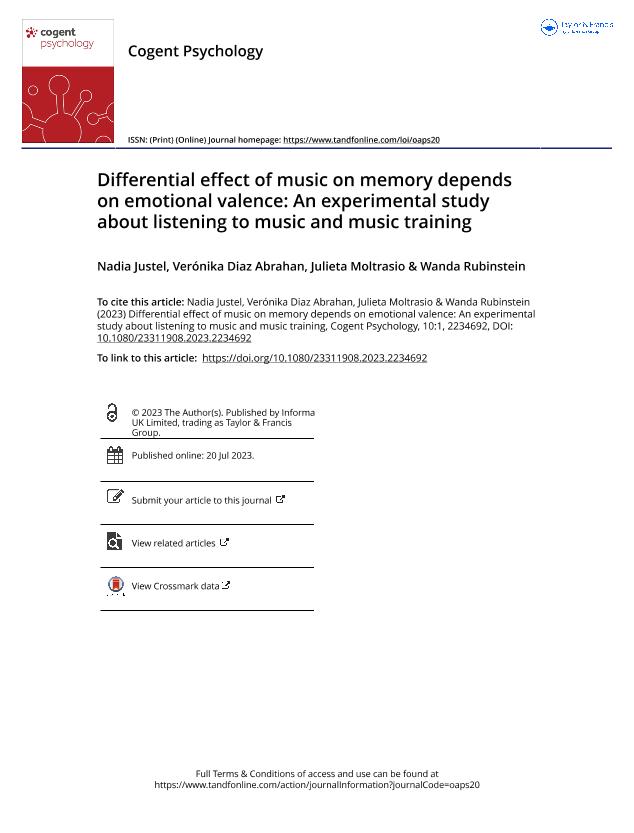Mostrar el registro sencillo del ítem
dc.contributor.author
Justel, Nadia

dc.contributor.author
Diaz Abrahan, Veronika Mariana

dc.contributor.author
Moltrasio, Julieta

dc.contributor.author
Rubinstein, Wanda Yanina

dc.date.available
2023-12-14T12:34:03Z
dc.date.issued
2023-07
dc.identifier.citation
Justel, Nadia; Diaz Abrahan, Veronika Mariana; Moltrasio, Julieta; Rubinstein, Wanda Yanina; Differential effect of music on memory depends on emotional valence: An experimental study about listening to music and music training; Taylor & Francis; Cogent Psychology; 10; 1; 7-2023; 1-17
dc.identifier.uri
http://hdl.handle.net/11336/220301
dc.description.abstract
Research has shown that memory is influenced by emotion. Several studies demonstrated the effectiveness of pharmacological and non-pharmacological interventions to modulate emotional memory pursuing clinical and educational aims. Music has been identified as a potential memory modulator, with results differing widely depending on whether the participant had musical training or not. The current study examined the effect of listening to music on musicians’ and non-musicians’ positive (study 1) and negative (study 2) emotional memory, in a group of 163 volunteers, aged 18–40. After the information was encoded, the groups of participants were exposed to arousing music (Symphony No. 70, D major by Joseph Haydn) or a control stimulus (white noise) for three minutes. Then memory was evaluated through free recall and recognition (immediate and deferred measures). Memory performance was compared between musicians (people with five or more years of music education) and non-musicians. Positive and negative images were better recalled than neutral ones, positive images were better recognized than neutral ones however neutral images were better recognized than negative ones. In Study 1, listening to white noise enhanced recall compared to listening to music. In Study 2, listening to arousing music enhanced recall compared to listening to white noise, and this effect was more pronounced in musicians than non-musicians. Our findings suggest that music has a great impact on memory, especially in those with experience in the field, which is reflected in cognitive performance.
dc.format
application/pdf
dc.language.iso
eng
dc.publisher
Taylor & Francis

dc.rights
info:eu-repo/semantics/openAccess
dc.rights.uri
https://creativecommons.org/licenses/by/2.5/ar/
dc.subject
AROUSING MUSIC
dc.subject
EMOTIONAL MEMORY
dc.subject
MODULATION
dc.subject
MUSIC TRAINING
dc.subject.classification
Otras Psicología

dc.subject.classification
Psicología

dc.subject.classification
CIENCIAS SOCIALES

dc.title
Differential effect of music on memory depends on emotional valence: An experimental study about listening to music and music training
dc.type
info:eu-repo/semantics/article
dc.type
info:ar-repo/semantics/artículo
dc.type
info:eu-repo/semantics/publishedVersion
dc.date.updated
2023-12-12T13:08:36Z
dc.identifier.eissn
2331-1908
dc.journal.volume
10
dc.journal.number
1
dc.journal.pagination
1-17
dc.journal.pais
Reino Unido

dc.journal.ciudad
Londres
dc.description.fil
Fil: Justel, Nadia. Consejo Nacional de Investigaciones Científicas y Técnicas; Argentina. Universidad de Palermo; Argentina
dc.description.fil
Fil: Diaz Abrahan, Veronika Mariana. Universidad de Palermo; Argentina. Consejo Nacional de Investigaciones Científicas y Técnicas; Argentina
dc.description.fil
Fil: Moltrasio, Julieta. Universidad de Buenos Aires. Facultad de Psicología. Instituto de Investigaciones; Argentina
dc.description.fil
Fil: Rubinstein, Wanda Yanina. Consejo Nacional de Investigaciones Científicas y Técnicas; Argentina. Universidad de Buenos Aires. Facultad de Psicología. Instituto de Investigaciones; Argentina
dc.journal.title
Cogent Psychology
dc.relation.alternativeid
info:eu-repo/semantics/altIdentifier/url/https://www.tandfonline.com/doi/full/10.1080/23311908.2023.2234692
dc.relation.alternativeid
info:eu-repo/semantics/altIdentifier/doi/http://dx.doi.org/10.1080/23311908.2023.2234692
Archivos asociados
